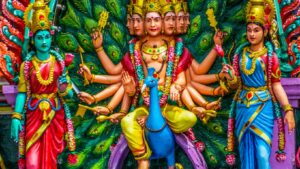Diving into the world of mythology, one can’t help but stumble upon the intriguing figure of the god of healing and medicine. From ancient civilizations to modern faiths, this divine entity has been a beacon of hope and healing, symbolizing the human desire to overcome illness and suffering.
In various cultures, the god of healing and medicine has different faces and names, yet they all share a common thread – the miraculous power to heal. Whether it’s the Greek god Asclepius, with his serpent-entwined staff, or the Hindu deity Dhanvantari, bearer of the elixir of life, these figures captivate us with their stories and symbolism.
God Of Healing And Medicine
As divine figures, gods of healing and medicine provide comfort and hope to believers. In historical periods, different cultures had unique deities responsible for healing. Let’s delve into these mystical figures, starting from Greek legends, traversing through ancient Egypt and ending in frosty Norse mythology.
Ancient Greek Influence: Asclepius
 Asclepius, the Greek god of healing and medicine, stands tall in the annals of Greek mythology. Revered as a able healer, even from mythology’s blurred lines, Asclepius’s fame remains.
Asclepius, the Greek god of healing and medicine, stands tall in the annals of Greek mythology. Revered as a able healer, even from mythology’s blurred lines, Asclepius’s fame remains.
- Tales tell of Asclepius’s mastery of medicine; he could bring the sick back to health and, on rare occasions, restore life to the dead.
- Snakes, often used to symbolize rebirth and renewal, were considered sacred to Asclepius. Their shed skin, symbolizing regeneration, complements Asclepius’s healing dominion.
Egypt’s Contribution: Imhotep
Egypt, the land of pyramids and pharaohs, recognized Imhotep as their god of medicine and healing. A historical figure transformed into a deity, Imhotep’s influence over medicine is substantial.
- Imhotep was initially a mortal, an architect and a priest, who rose to the rank of deity on account of his healing abilities.
- Writings from the period mention Imhotep treating diseases and injuries using medicinal herbs, providing a glimpse into the knowledge he possessed.
- Recognizing this, later Egyptian pharaohs and nobles venerated Imhotep as a healing deity, leading to his eventual deification.
Norse Mythology: Eir, the Healer
 In snow-laden landscapes of Norse Mythology, Eir, a relatively enigmatic figure, takes the mantle of healing and medicine. Through uncovering the narratives of Asclepius, Imhotep, and Eir, it becomes clear that across cultures and ages, the god of healing and medicine has held a significant place in societal structures. More than mere formidable figures of lore, they represent hope, healing, and the human yearning for a reprieve from suffering.
In snow-laden landscapes of Norse Mythology, Eir, a relatively enigmatic figure, takes the mantle of healing and medicine. Through uncovering the narratives of Asclepius, Imhotep, and Eir, it becomes clear that across cultures and ages, the god of healing and medicine has held a significant place in societal structures. More than mere formidable figures of lore, they represent hope, healing, and the human yearning for a reprieve from suffering.
Attributes and Symbols of the God of Healing and Medicine
The diverse symbols associated with the god of healing and medicine provide unique insights into their divine roles. From the serpent-clad Rod of Asclepius to the globally recognized Hippocratic Oath, and the mystical association between serpents and healing rituals, each of these symbols holds profound meaning.
The Rod of Asclepius
The Rod of Asclepius, a symbol attributed to the Greek god of medicine, consists of a single serpent coiling around a rod. It signifies the miracle healing capacity Asclepius possessed. It’s a powerful symbol popular in the medical field worldwide and can be seen on ambulances, hospitals, and medical uniforms. Numerous medical organizations such as the American Medical and the World Health Associations use this symbol, indicating their commitment to healthcare and the betterment of human lives.
The Hippocratic Oath
 Aligned with Asclepius, the Hippocratic Oath forms a significant attribute of the medical god. Citing Hippocrates, the ancient Greek physician, this oath outlines the ethical duties of physicians. It advocates for health and well-being and stresses the importance of maintaining patient confidentiality, non-maleficence, and doing no harm. Healthcare professionals across time and space have taken this oath, reinforcing their resolve to safeguard human health.
Aligned with Asclepius, the Hippocratic Oath forms a significant attribute of the medical god. Citing Hippocrates, the ancient Greek physician, this oath outlines the ethical duties of physicians. It advocates for health and well-being and stresses the importance of maintaining patient confidentiality, non-maleficence, and doing no harm. Healthcare professionals across time and space have taken this oath, reinforcing their resolve to safeguard human health.
Serpents and Healing Rituals
Serpents hold symbolic value in the realm of divine healing. In the context of Asclepius, they symbolize rejuvenation and rebirth, owing to their ability to shed their skin. Ancient temples dedicated to Asclepius often housed non-venomous snakes, where supplicants engaged in incubation rituals, seeking healing through dreams. There’s a strong association between serpents and healing rituals across different cultures, conclusively indicating their universal acceptance as symbols of health and rejuvenation.

